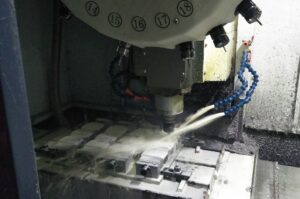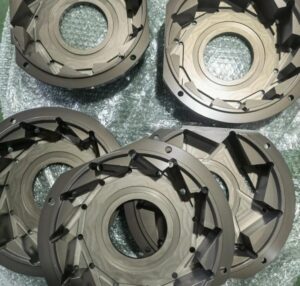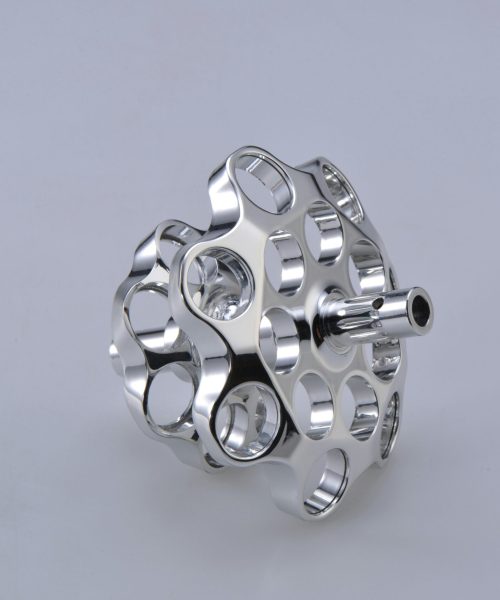The manufacturing industry has undergone significant transformation over the past century. Initially, simple machine configurations sufficed, as precision was not a critical factor. However, with advancements in technology and mobility, the need for precise components in critical applications such as aerospace and automotive industries has grown exponentially. This demand for exactness has led to the development of precision machining.

This article explores the concept of precision machining in manufacturing, focusing on the essential processes and tools that ensure high precision.
Key Concepts in Modern Manufacturing
Manufacturing has rapidly evolved from simple assemblies managed by numerous technicians to highly automated processes dominated by CNC (Computer Numerical Control) machines. Below are key terms frequently encountered in advanced manufacturing:
Hassas İşleme
Precision machining involves the use of sophisticated machines designed to fabricate parts with exceptionally high accuracy and strict tolerances. These machines utilize advanced control systems, often guided by CNC technology, to perform precise cutting, milling, turning, or drilling operations.
Precision Manufacturing
Precision manufacturing encompasses a set of practices and processes aimed at producing components with high precision. It involves using precision machines, rigorous quality control measures, and advanced technologies to ensure products consistently meet exact specifications.

CNC Manufacturing
CNC manufacturing utilizes CNC machines programmed to perform designated operations with high precision and efficiency. This technique streamlines the production process and enhances the quality of manufactured parts.
Computer-Aided Design (CAD)
CAD involves creating detailed and precise digital models of physical components on a computer. Designers and engineers use CAD software to construct, modify, analyze, and optimize designs before any physical prototype is made.
Understanding Precision Machining
Precision machining is a subtractive manufacturing process that uses high-speed CNC machines to create complex geometries with exceptional accuracy and strict tolerances. The aim is to produce parts very close to the dimensions of the digital design, with tolerances ideally within a thousandth of an inch. CNC precision machines receive instructions from a computer system and replicate these dimensions in the final part.

Importance of Precision in Modern Machining
Precision machining is crucial for ensuring the operational integrity, safety, and market viability of manufactured products. It is essential for sectors like aerospace and medical devices, where even minor deviations from specified dimensions can lead to severe consequences, including system failures that may jeopardize lives. Precision machining enables flawless integration and dependable performance under rigorous conditions.
Moreover, high-tech components, such as those in electronics and quantum computing, rely heavily on precision machining for producing complex and miniaturized parts. Maintaining stringent precision in machining processes is also vital for meeting the highest quality standards, thereby sustaining a manufacturer’s reputation and building consumer trust.

The Precision Machining Process
Precision machining involves several carefully planned steps to produce a part that perfectly matches its design:
- Design Using CAD (Computer-Aided Design) The process begins with a rough sketch, which is then refined using CAD software to create a graphical model. Popular CAD tools include AutoCAD and SolidWorks, known for their robust 3D design capabilities.
- Conversion to CAM (Computer-Aided Manufacturing) CNC machines require machine-readable code to interpret a graphical model. Modern CAD software includes CAM capabilities to convert 3D models into G-codes and M-codes, which define the cutting tool paths and manage auxiliary functions.
- Material Selection and Preparation Material choice depends on the part’s requirements, machinability, and cost. For example, steel is commonly used for its hardness and strength, while aluminum is preferred for its lightweight properties in aerospace applications.
- Setup of Precision Machinery Setting up the machine involves selecting and calibrating precision tools, checking fluid and coolant levels, and possibly running a dry run to ensure everything is set correctly.
- Execution of Machining Once set up, the machining process begins, with initial stages monitored for adjustments. Technicians may need to calibrate tool positions or modify feed rates to accommodate material variations.
- Post-Processing Steps Precision machined parts may require additional finishing, such as polishing or grinding, followed by quality assurance checks to confirm adherence to precise dimensions.
Types of Precision Machining Machinery
Different CNC precision machines are designed to achieve various degrees of precision:
CNC Milling Machines
CNC milling machines use rotary cutters to remove material from a workpiece. They perform operations like pocket milling, profile milling, and surface contouring. Configurations include knee mills, bed mills, turret mills, C-frame, and gantry mills.

CNC Turning Centers (Lathes)
CNC lathes rotate the workpiece against a fixed cutting tool, creating precise symmetrical shapes. Some lathes incorporate live tooling for additional processes such as tapping, milling, and drilling.
Swiss-Type Lathes
Swiss-type lathes feature a linearly moving headstock and guided bush for precise workpiece movement, ideal for producing extremely small and intricate parts.
Multi-Axis Machining Centers
These machines offer movement in multiple axes (up to 12), allowing for intricate and complex parts to be machined without repositioning the workpiece.
Mill-Turning CNC Centers
Combining CNC milling and turning capabilities, these centers perform multiple operations on a single machine, reducing handling between processes.
CNC Grinding Machines
Precision grinders use abrasive wheels to achieve high-accuracy surface finishes and tight dimensional tolerances on parts.
CNC Drill Presses
CNC drill presses feature a stationary workpiece and a rotating drill bit to create precise holes, primarily used for fastener or assembly operations.

Electrical Discharge Machines (EDM)
EDM machines use electric discharges to shape materials, ideal for hard or fragile materials that cannot withstand mechanical stresses.
Laser Cutting and Engraving Machines
Laser machines use high-power lasers to cut, engrave, or mark materials, suitable for both metals and non-metals.
Water Jet Cutters
Water jet cutters use high-pressure water mixed with abrasives to cut materials without introducing heat, preventing material distortion.
Selecting Materials for Precision Machining
The choice of material is critical for precision machining. Here’s a table summarizing popular materials, their characteristics, machinability, and end-use cases:
| Class | Malzeme | Characteristics | Machinability | End Uses |
|---|---|---|---|---|
| Metal | Alüminyum | Lightweight, corrosion-resistant | Easy | Automotive parts, aircraft components |
| Paslanmaz Çelik | High corrosion resistance, strong | Varies by alloy | Medical devices, marine applications | |
| Pirinç | Good corrosion resistance, easy to machine | Very easy | Plumbing fittings, electrical connectors | |
| Bakır | Excellent conductivity | Moderate | Electrical wiring, heat exchangers | |
| Bronze | Strong, corrosion-resistant | Difficult | Bearings, marine hardware | |
| Titanyum | Lightweight, strong, corrosion-resistant | Difficult | Aerospace structures, medical implants | |
| Plastikler | ABS | High strength, toughness | Easy | Automotive components, consumer goods |
| PC (Polycarbonate) | Impact-resistant, transparent | Moderate | Safety equipment, optical lenses | |
| PMMA (Acrylic) | Transparent, lightweight | Easy | Signage, displays | |
| POM (Acetal) | High stiffness, wear-resistant | Moderate | Precision gears, electrical components | |
| PA (Nylon) | Strong, wear-resistant | Moderate | Gears, automotive components | |
| PEEK | High temperature and chemical resistance | Difficult | Aerospace parts, medical equipment | |
| Composites | FRP (Fiberglass Reinforced Plastic) | Good strength-to-weight ratio | Moderate to difficult | Automotive body panels, marine vessels |
| Ceramics and advanced materials | Alumina | Excellent hardness, wear resistance | Very difficult | Cutting tools, wear-resistant components |
| Zirconia | High strength, heat resistance | Very difficult | Dental implants, ball bearings | |
| Silicon Carbide | Extremely hard, thermal resistance | Very difficult | High-performance aerospace, nuclear parts |
Considerations for Material Selection
When selecting materials, consider machinability, physical properties, cost, and applications. Hardness and strength are crucial for machinability, with harder materials being more challenging to machine but excellent for tooling. Cost is also a significant factor, especially in high-volume production.
Applications of Precision Machining Across Industries
Precision machining is vital in various industries where parts must fit together seamlessly. Applications include:
| Industry | Specific Applications |
|---|---|
| Havacılık ve Uzay | Aircraft engines, structural components |
| Medical | Surgical instruments, implants, prosthetics |
| Otomotiv | Gear components, engine parts, couplings |
| Elektronik | Connectors, circuit boards, enclosures |
| Tool and Die Making | Molds, dies, cutting tools, jigs and fixtures |
| Energy | Turbine components, drilling equipment |
| Defense | Weapon prototypes, missile systems, armored vehicle parts |
Advantages of Precision Machining Techniques
Manufacturers adopt precision CNC machining for several advantages:
High Accuracy and Tight Tolerances
Precision machining achieves high accuracy and tight tolerances, typically around 0.005 inches, ensuring parts meet exact specifications.
Complexity and Flexibility
Precision machining enables the creation of complex geometries with high accuracy, essential for industries like aerospace and medical. CNC machines offer flexibility, allowing quick design adjustments through software parameters, facilitating efficient prototyping and customization.
Efficiency and Speed
CNC machines significantly speed up machining time due to automation and control systems, making them 200 to 300 times faster than traditional machines. CAD/CAM integration further improves speed and efficiency.
Improved Quality and Reliability
Computerized control ensures identical parts within specified dimensions, reducing errors and minimizing the need for secondary finishing. Precision machining reduces waste and produces consistent, high-quality parts.
Maliyet-Etkililik
While initial setup costs are high, precision machining is cost-effective for large-scale and customized production. Automation reduces labor costs, and precise cutting minimizes material waste.
Accuracy vs. Precision in Machining
Accuracy refers to how close a part’s measurements are to design specifications, while precision measures the consistency of output across multiple productions. Precision ensures repeatable accuracy, even if not close to a specific value.
Potential Drawbacks of Precision Machining
Yüksek İlk Yatırım
Advanced functionalities of CNC machines result in high initial costs, with industrial-level machines starting at $100,000.
Complex Setup and Operation
Setting up CNC machines is complex, requiring skilled machinists, adding to labor costs.
Economic Scalability
CNC machining may not be economically viable for large production runs due to high setup costs and time required for machine configuration.
Outsourcing Precision Machined Products
Outsourcing precision machining is practical when demand is infrequent. GCH Process offers comprehensive precision machining services, ensuring each component meets stringent quality standards. Our services include precision CNC milling, turning, grinding, and EDM with tolerances up to 0.01mm.

Sonuç
Precision machining is essential for producing intricate assemblies and micro-parts that must synchronize perfectly. With various CNC machining equipment available, precision machining ensures components meet exact dimensions. As technology advances, the significance of CNC precision machining will continue to grow. Contact GCH Process to learn how we can support your manufacturing goals with precision and reliability.
SSS
Otomotiv endüstrisi için CNC işleme ile hangi ürünler yapılır?
Otomotiv endüstrisinde CNC ile işlenmiş prototipler far kapaklarından motorlara kadar her şeyi içerebilir. CNC işleme ayrıca silindir kafaları, marş motorları, dişli kutuları ve nadir ve klasik otomobiller için özel bileşenler gibi son kullanım otomobil parçaları da üretir.
Otomotiv sektöründe ne tür CNC makineleri kullanılır?
Basit veya tek taraflı otomobil parçaları çeşitli CNC makineleri kullanılarak yapılabilir. Ancak silindir kapakları ve blokları gibi karmaşık parçalar için genellikle daha geniş bir kesici takım açısı yelpazesi sunan ve sıkı toleranslarla son derece karmaşık geometrilerin oluşturulmasını sağlayan pahalı 5 eksenli işleme merkezleri gerekir.
Otomotiv CNC işlemede hangi malzemeler kullanılır?
Farklı parçalar, metaller ve plastikler de dahil olmak üzere farklı malzemeler gerektirir. Örneğin, silindir blokları ve kafalarının üretiminde genellikle mükemmel ısı yayma özellikleriyle bilinen alüminyum kullanılır.
By expanding the discussion on precision machining for the automotive industry and including detailed insights into applications, advantages, and comparisons with other technologies, this comprehensive guide provides a well-rounded perspective for readers.








